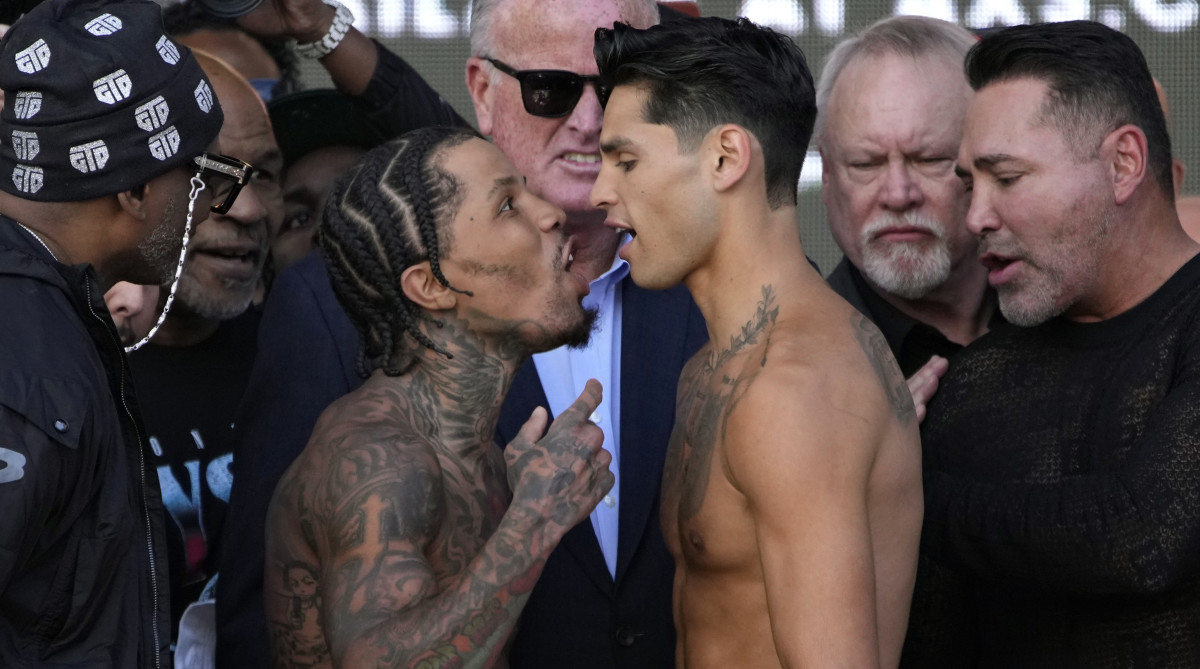Tank Davis-Ryan Garcia Is the Fight That Boxing Needs

Tank Davis.
Ryan Garcia.
Let’s. Freaking. Go.
Boxing is a maddening sport. At its best, it’s peerless. Think about the most memorable atmosphere you have ever felt at a sporting event. I promise you: Floyd Mayweather-Manny Pacquiao was better. The rush of an NBA Finals Game 7? Give me Tyson Fury-Deontay Wilder. The buzz of a Super Bowl? I’ll take the first fight between Canelo Alvarez and Gennadiy Golovkin.
Too often, though, it’s at its worst. For every Mayweather-Pacquiao there were a dozen duds. For every Fury-Wilder—and all three of their matchups were worth the price—you are forced to shell out for Wilder-Luis Ortiz. Top fighters are inactive. Natural fights fail to get made. Economics have forced fights once earmarked for premium cable onto pay per view. Instead of attracting new fans, boxing is more interested in bleeding its most dedicated ones.
Davis-Garcia won’t save boxing. But it will draw fresh eyeballs to it. Three things make a super fight: skill, power and popularity. Davis-Garcia has them all. Davis is 28–0. Garcia is 23–0. Davis has knocked out 93% of his opponents. Garcia has stopped 83%. Davis has drawn huge crowds in Los Angeles, Atlanta and Brooklyn. Garcia has nearly 10 million Instagram followers and endorsement deals with Gatorade, Dior and 1800 Tequila. T-Mobile Arena in Las Vegas will be sold out on Saturday with a live gate that will exceed $10 million. Pay per view buys should rise to mid six-figures.
Davis is self-made. He escaped poverty, established himself as a top amateur and turned pro. He eventually aligned himself with Floyd Mayweather and built himself into one of boxing’s biggest attractions. Critics—and I’ve been one of them—can harp on Davis’s resume. They can’t deny his connection with an audience—or his prodigious talent.

Garcia’s upbringing was more stable. He grew up in southern California and fought his way up the amateur ranks before turning pro. He built his record fighting in barrooms in Mexico, signed with Golden Boy and quickly emerged as one of boxing’s most explosive punchers. Skeptics—and there are many—say Garcia is more style than substance. Garcia’s recent opponents, including Luke Campbell and Javier Fortuna, would disagree.
There’s an unpredictability to this fight. Davis by knockout? Oddsmakers have pegged that as the most likely outcome. Davis, 28, is more experienced. As the unofficial “A” side he forced Garcia, who has fought at 140 pounds his last two fights, to squeeze down to 136 … and tacked a 10-pound rehydration clause on it. In 2021, Garcia was knocked down by Campbell. Campbell, like Davis, is a southpaw but with a fraction of the power. If Davis connects on that kind of shot, it’s over.
Garcia by stoppage? I’d believe that, too. Garcia’s speed is blurring. His power is undeniable. Campbell went the distance with Jorge Linares and Vasyl Lomachenko. Garcia dispatched him in seven. Fortuna, a 130-pound title holder, didn’t make it out of the sixth. Garcia, 24, will have a four-inch height advantage over Davis. To get inside, Davis may have to take chances. Garcia, a powerful counterpuncher, can capitalize if he does.
A decision? Seems unlikely but, sure. Davis is a judicious puncher. Garcia can be selective, too. If both fighters are wary of the other's power—and if both have sturdy enough chins to take it—this one could go to the cards.
There’s animosity. Real animosity. At Thursday’s press conference, Davis promised to punish Garcia. To break his jaw. “Don't even bring your mother,” Davis said. “Or your daughter." Garcia promised to crack his. “I just need one shot,” said Garcia. “That left hook. I feel like I’m going to break his jaw with that hook. I just see him lying on the floor.” At the weigh-in Davis nearly got into a scuffle … with Garcia’s promoter, Bernard Hopkins.
It's been suggested Davis-Garcia could open the door for other big fights. This wasn’t an easy deal to make. There were rival promoters. Rival networks. Concessions, most by Garcia, needed to be made. That this fight came together should mean other big events (Terence Crawford-Errol Spence, Jaron Ennis-Vergil Ortiz) can too.
Don’t count on it. Boxing is fractured and likely will remain that way. Promoters will silo themselves off, hiding behind contracts and network deals. Fighters will battle harder on social media than they do in the ring. Larry Merchant, the Hall of Fame broadcaster, once said “nothing will kill boxing … and nothing can save it.” Mayweather-Pacquiao didn’t. Davis-Garcia won’t, either.
Still, for one night, boxing is giving us something. For purists, it’s a reward—albeit a pricey one—for hanging in there. For the casual fan, it’s a reason to watch. Davis-Garcia represents everything boxing should be. Even when it’s not.
